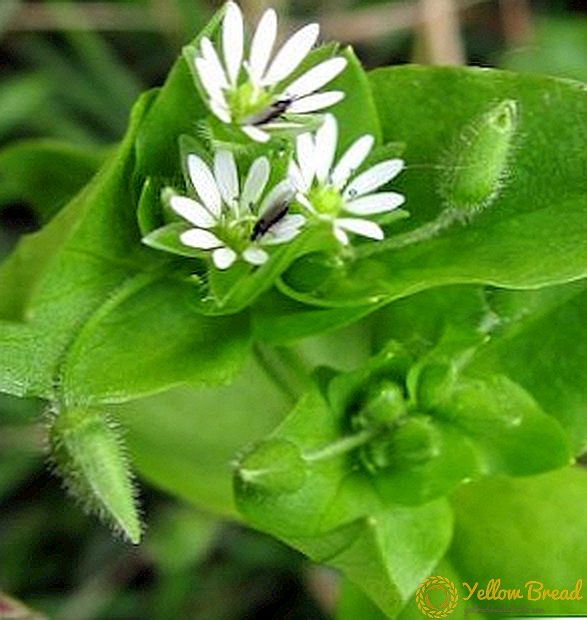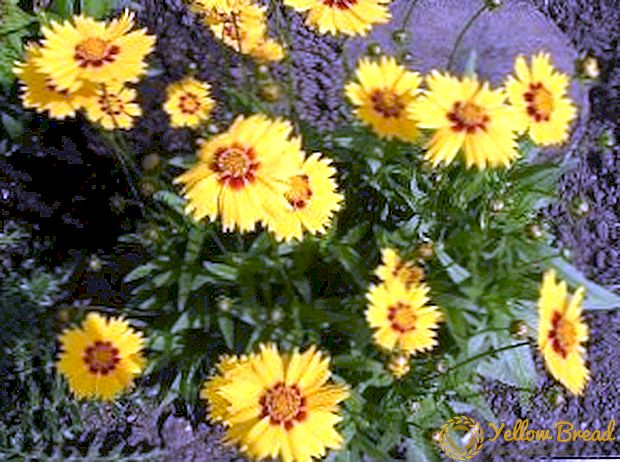
If eggplants turn yellow or wilt without cause - do not rush to make hasty conclusions and destroy plants with shock doses of fertilizers.
To get started, look at the seedlings: its appearance may indicate the reason why the seedlings die.
Today we will find out why eggplant seedlings wither and fall? What to do if the leaves are dried in seedlings eggplant?
Why do the leaves of eggplant seedlings turn yellow?
 The main reasons why eggplant seedlings turn yellow:
The main reasons why eggplant seedlings turn yellow:
- nitrogen-poor soil;
- excess moisture;
- fungal infection root system - fusarium, verticillus;
- direct sunlight.
Nitrogen deficiency
The soil is not the only but important source of nitrogen for growing eggplants. If a plant does not receive a sufficient amount of a macroelement through the root system, then it draws the necessary material for building new cells from itself.
The oldest, the lower cotyledon leaves, appear to be at risk; they appear to be less of a priority for the plant than the upper ones that grow.
Neatly dig out the plant and free its underground part from the soil. If the root system is intact, and the cotyledon leaves turn yellow and wither - seedling emergency fertilizing with nitrogenous fertilizer is required.
Remember that it is necessary to use the acquired funds strictly according to the instructions in order not to overdo it with the dosage and not to harm the seedlings.
Unsuitable soil moisture
Excess soil moisture has the opposite effect on seedling: yellowing begins at the top. During the inspection of the root system, wet particles of earth are found between the intertwined roots.
 At the bottom and walls of the containers with seedlings there is stagnant water and moist green scurf - a sign of the growth of fungal flora.
At the bottom and walls of the containers with seedlings there is stagnant water and moist green scurf - a sign of the growth of fungal flora.
The relief measures are: whenever possible replace the soil in the seedling box.
If the water stagnates at its bottom - make several large drainage holes and be sure to place the box on the pallet.
Fusarium
Fusaria - soil fungus that infects weakened plants. Often, disputes are brought into the ground with untreated seeds. Under favorable conditions, destructive fungi form from spores, penetrating into plants through injured roots or sores on the stem.
The appearance of eggplant, affected by fusaria, has:
- growth retardation;
- brown color of the stem and its cut;
- pink bloom on the rootsextending to the ground part of the seedling;
- yellowed leaves with light streaks;
- yellow cotyledon leaves twisted in tubules.
You can help the plants as follows:
- remove the perishing plants from the box, sifting those that can still be saved into a separate container;
- to replace the soil box for seedlings;
- use the fungicidal agent (Benazol, Fundazol, Strekar, Trichodermin) according to the instructions.
Verticillosis
 Another enemy of eggplants is the fungus Verticillium. The result of the introduction of this parasite in the plant is yellowing and fast leaf fall. The defeated seedling dies.
Another enemy of eggplants is the fungus Verticillium. The result of the introduction of this parasite in the plant is yellowing and fast leaf fall. The defeated seedling dies.
The following signs will help to recognize the diseased plant:
- amazed leaves look mottled, fading, their yellowing begins with streaks;
- after changing their color eggplant vegetative parts wilt: they twist into a spiral and fall off, giving the impression that the leaves burned with boiling water;
- on the cut the stem is brown.
Tactics of struggle:
- immediately remove diseased seedlings (it is better to burn them so that the fungus does not settle in the compost pit;
- plant healthy eggplants in a new crate with earth;
- treat and prevent fungicides: Previkur, Rovral, Topsin.
UV rays
Direct long-term exposure to ultraviolet radiation is fraught with the disintegration of chlorophyll, a green respiratory cytochrome necessary for a plant for photosynthesis.
 Leavesburned may have yellow specks or turn yellow completely.
Leavesburned may have yellow specks or turn yellow completely.
Note that only the upper surfaces of the leaves facing the sunny side of the window or greenhouse are affected. If so, then rest assured - cause sunburn.
If your seedlings are exposed to prolonged exposure to the open sun, they should be covered with paper or cloth from 12:00 to 15:00.
Watch a short video on how to deal with yellowing:
Why does eggplant seedlings fade?
If young plants dry out, make sure that one of the factors does not affect the seedlings:
- hypothermia low soil temperature;
- insufficient watering;
- recent picking or transplanting;
- fungal infection.

Cold soil
The soil-heated fluid enters the vegetative organs of the eggplants through the plant's conducting system.
If the ground temperature is not high enough moisture transport processes are disrupted.
The plant is dehydrated despite sufficient watering.
Find out if the soil is not cooled by a draft or cold air from the street. Measure the ambient temperature - if it is not high enough, use artificial heating of the soil and watering seedlings with warm water 25-28°.
Dehydration
With insufficient watering leaves look sluggish, thin and fall down under its own gravity. A change in the color of the vegetative parts of the seedling is not characteristic of a lack of moisture in the plant. The need to change the mode of watering seedlings will indicate a dry lumpy soil.
You can read about how to properly organize the watering of eggplant seedlings, here.
Stress
Wilting of the cotyledon leaves of the eggplant after picking or transplanting is considered permissible.
Due to the forces lost by the plant during adaptation to the new environment and damage to a part of the root system, old lower leaves may die in eggplant. If you notice that the top of the plant dries out - the reason is not the change of soil.
Fungus
 Early manifestations of fungal ailments may look like a causeless withering of eggplants.
Early manifestations of fungal ailments may look like a causeless withering of eggplants.
Vertical wilting is most dangerous. - late diagnosed and practically incurable disease. A green cut of the root part of the seedling stem will help to eliminate the fungal damage to the seedlings.
On the way to harvest
Finding the reasons for the change in the status of seedlings, making the correct diagnosis and providing emergency care to a drooping plant is a big step towards a rich harvest.Daily observation of young plants and their simple, but necessary requirements will help you in this responsible matter.
Useful materials
Read other articles about growing and caring for eggplant seedlings:
- Different methods of cultivation: in peat tablets, in a snail and even on toilet paper.
- All features of sowing according to the lunar calendar.
- Golden rules for growing from seed.
- Features of cultivation in different regions of Russia: in the Urals, in Siberia and the Moscow region.
- Read more about seed preparation before planting.






